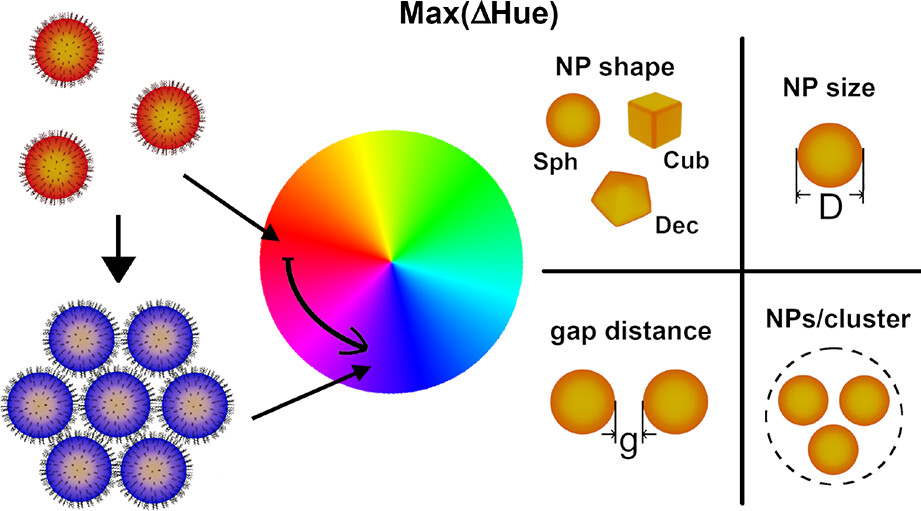Optimal colorimetric sensing based on gold nanoparticle aggregation
Spurred by outstanding optical properties, chemical stability, and facile bioconjugation, plasmonic metals have become the first-choice materials for optical signal transducers in biosensing. While the design rules for surface-based plasmonic sensors are well-established and commercialized, there is limited knowledge of the design of sensors based on nanoparticle aggregation.
The working principle of biosensors built around plasmonic nanoparticles is based on their localized surface plasmon resonances, coherent oscillations of the free electrons in metals usually driven by an incident electromagnetic wave. The most general approach for plasmonic sensing is based on a spectral shift of the plasmon resonance as a response to the selective binding of an analyte to a metal surface (change in local refractive index). Although highly reproducible and quantitative, plasmonic sensors based on spectral shifts are difficult to implement as a mass testing method since they usually require sophisticated optical readouts, such as spectrophotometers and data processing. Besides, a single wavelength data analysis, often implemented in spectral sensors, can lead to information loss. Thus, spectral sensors are convenient for centralized laboratory testing, operated by expert personnel.
On the other hand, plasmonic sensing, particularly gold nanoparticles, involves their selective aggregation in the presence of surface-binding bio(macro)molecules. When a colloidal solution of gold plasmonic nanoparticles aggregates in the presence of molecules (e.g., DNA), the solution turns from red to blue as a result of the so-called plasmon coupling. The readout assessment through color change does not require spectrophotometers and data interpretation by expert users. In addition, the readout can be digitalized in situ with mobile devices and converted into a given color space (RGB) that conveys more information than single-wavelength data analysis.
As the recent pandemic has demonstrated, colorimetric sensing based on gold nanoparticles is a convenient tool for mass testing, where the untrained human eye completes the readout without medical assistance. Facile fabrication, low cost, fast readout, and societal acceptance pave the way toward further improvements of this type of sensor by taking advantage of the outstanding optical properties of gold nanoparticles.
One of the most important improvements in colorimetric sensing based on gold nanoparticles is related to their aggregation. Actually, even though sensing by aggregating nanoparticles has improved considerably over the last years, its commercial use remains out of reach. The main reason is that aggregating nanoparticles can lead to inhomogeneous interparticle distance and uncertainties in the number of nanoparticles per cluster or mutual arrangement, affecting the readout consistency and reproducibility.

To tackle these issues, now, a team of researchers establishes 1 a set of optimal parameters─size, shape, and interparticle distance of gold nanoparticles─ for reaching the largest possible color difference in visible spectral range upon clustering.
As an experimental model implementation, the researchers selected DNA-driven aggregation of nanoparticles stabilized with complementary single-stranded DNA. Numerical calculations and experimental data show that decahedra with an edge length of 30 nm forming clusters of 10 units at 2 nm interparticle distance are the best-performing nanoparticles in terms of red-to-blue color transition in RGB space.
The analysis focused on aggregating one type of nanoparticles, of the same size and shape. The aggregation of nanoparticles via biomacromolecules, in particular, DNA, makes heterogeneous clustering possible, where one can use two batches of nanoparticles of different shapes. Such a strategy can lead to the formation of satellitelike structures with much richer optical responses as compared to homogeneous clusters of the same shape. The systematic codification of specific cluster architectures with their optical outcome at the aggregated state can open up the possibility of colorimetric multiplexing.
The team’s proposed methodology of calculating hue values from input spectra opens up the possibility for tracking color transition in real-time through computer vision, where the resolution between colors of such transitions can be considerably augmented. As such, finding a linear relationship between the hue value transition and the analyte concentration would pave the way for a quantitative readout.
Author: César Tomé López is a science writer and the editor of Mapping Ignorance
Disclaimer: Parts of this article may have been copied verbatim or almost verbatim from the referenced research paper/s.
References
- José Luis Montaño-Priede, María Sanromán-Iglesias, Nerea Zabala, Marek Grzelczak, and Javier Aizpurua (2023) Robust Rules for Optimal Colorimetric Sensing Based on Gold Nanoparticle Aggregation ACS Sens. doi: 10.1021/acssensors.3c00287 ↩